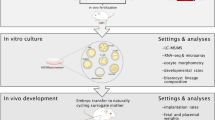Abstract
MOUSE ova collected from the Fallopian tubes at the eight-cell stage have been consistently shown to develop to blastulae when cultivated in a purified medium1. It has now been observed that if progesterone is added to this medium, all ova die when the concentration is 8 µgm./ml. or more. A proportion survive at 4 µgm./ml., while a concentration of 2 µgm./ml. is without apparent effect. Since Forbes2 found a level of 5.2 µgm./ml. in human plasma it seemed possible that this action of progesterone, together with those described by Pincus3 and Ishikawa4, might provide a method of fertility control. However, when recently inseminated mice were injected with 10 mgm. of progesterone intraperitoneally on two successive days, there was no reduction in the number of free blastulæ or of implantation sites.
This is a preview of subscription content, access via your institution
Access options
Subscribe to this journal
Receive 51 print issues and online access
$199.00 per year
only $3.90 per issue
Buy this article
- Purchase on SpringerLink
- Instant access to full article PDF
Prices may be subject to local taxes which are calculated during checkout
Similar content being viewed by others
References
Whitten, W. K., Nature, 177, 96 (1956).
Forbes, T. R., Amer. J. Obs. and Gynaec., 60, 180 (1950).
Pincus, G., cited by Zuckerman, S., Nature, 177, 58 (1956).
Ishikawa, M., cited by Zuckerman, S., Nature, 177, 58 (1956).
Cornforth, J. W., Hart, P. D'Arcy, Rees, R. J. W., and Stock, J. A., Nature, 168, 150 (1951).
Mackaness, G. B., Amer. Rev. Tuberc., 69, 690 (1954).
Rees, R. J. W., Proc. Roy. Soc. Med., 46, 581 (1953).
Lovelock, J. E., and Rees, R. J. W., Nature, 175, 161 (1955).
Author information
Authors and Affiliations
Rights and permissions
About this article
Cite this article
WHITTEN, W. Physiological Control of Population Growth. Nature 178, 992 (1956). https://doi.org/10.1038/178992a0
Issue date:
DOI: https://doi.org/10.1038/178992a0



